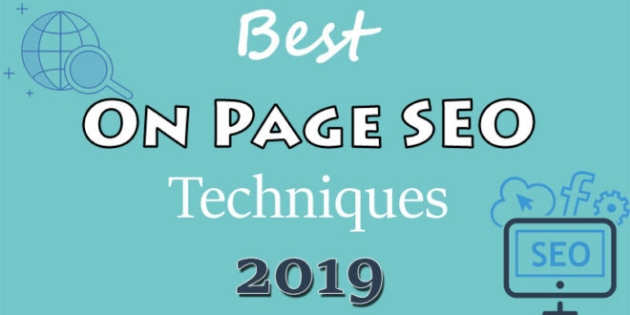7 On-page SEO Techniques to Rank First on Google in 2019
Everybody knows and speaks about the importance of SEO for better visibility in search engines, which eventually leads to more conversions and sales. If somebody tells you that SEO is dead, don’t believe them.
Search engine optimization is alive and kicking. You only need to implement the best SEO strategies properly and be willing to invest a lot of time and energy into it, since it is a long process that will pay off in the long run.
Both off-page and on-page SEO techniques are important for improving your website ranking. However, this specific article is dedicated to helping you to master on-page SEO.
The Importance of On-page SEO
If you’re wondering why on-page SEO is so important, here is the answer:
Everything starts with your website, it’s like home to your business. So, if you want to improve your search engine ranking, you need to start with the strategies that optimize your web pages for search engines.
That’s why on-page SEO is crucial to your business. Once you have optimized your website for search engines, it is much easier to pursue the most effective off-page SEO strategies and be successful in this quest.
When you optimize your website in a natural and smart way, search engines can easily pick out the target keyword and show your website to visitors searching for those keywords.
Here are the best on-page SEO techniques to use on your website.
H1 and H2 Tags
Your blog post title needs to be in an H1 tag. Period.
If you use WordPress or another CMS that automatically adds the H1 to your blog post title, then you don’t need to worry. However, make sure that you always check your site’s code because there are some themes that override this setting.
Speaking of which, choosing the right website builder can significantly improve your SEO in many other aspects.
Furthermore, just like your title should be in H1, your subheadings should be in H2 (and sometimes H3). Also, include your keyword in some of your H2 subheadings, as this positively affects your page visibility.
Meta Description
Adding a unique and relevant meta description to each post is not only recommended, but it is absolutely necessary.
Even though search engines don’t directly consider meta descriptions as a ranking factor, descriptions are very useful to visitors, as they explain the post and increase the number of clicks.
Use your targeted keyword in your meta description, but never overuse it because this may lead to keyword stuffing and Google penalties.
The key here is to write logical, user-friendly meta descriptions that are related and relevant to your post.
Keywords
Search engine optimization is based on keywords, so they are considered as the most important element of your SEO efforts. Once you monitor competitors to find the best performing keywords, you can use them in multiple ways to improve your ranking.
Title – Since your title tag is a crucial part of your on-page SEO, it is important to start your title with the focus keyword.
For example, if you are writing about the best headphones, you want a title like this one: The Best Headphones ‒ 2019 Review
SEO-friendly URLs – Your URLs need to be short and easily readable. To rank high in search engines, it is ideal to have URLs that are 3 to 5 words long. Also, make sure that you always include the focus keyword in the URL.
Example: best-headphones-2019-review
Use the main keyword in the first 100 words – You want to show what your post is about right away. This way, Google can immediately see your topic when it starts crawling the article.
That is why your targeted keyword should appear as early as possible in your article, ideally in the first 100 words.
Include LSI keywords – LSI (Latent Semantic Index) keywords are words and phrases that are related to your main keyword and used to build a concept around your topic.
In the example of headphones review, you would want to include phrases like earphones, music, songs, etc.
Keyword ratio – The final tip regarding keywords is to use them in moderation. If you stuff your post with keywords, Google will impose a penalty on your website. Always follow the keyword golden ratio, and you will be safe.
Website Speed
Did you know that websites that take more than 4 seconds to load are frowned upon by Google?
Your website speed plays a major role in your SEO ranking, so you want to create a website that allows your visitors fast browsing, especially if you are in the e-commerce industry.
The best thing you can do to improve your website speed is to choose your hosting provider carefully as well as use one of the top CDNs (Content Delivery Networks).
Images
There are two main things you should consider when uploading images to your website: image optimization and alt tags.
Optimization – Images can make or break your website, as their quality is really important on the one hand, while on the other they take most of your website load time.
That is why you need to optimize them for search engines or simply reduce their size using a compression tool.
Alt tags – Google is very smart, but it can’t read images yet. In order to understand them, it uses the image’s alternate text. Alt tags describe to search engines what the image is about, but also to people in case the image won’t load for some reason.
Your alt text needs to be up to 125 characters and contain your targeted keyword.
However, make sure not to include your focus keyword in each alt text since this may lead to keyword stuffing. Instead, use long tail keywords and LSI keywords to spice it up and get a better effect.
Linking
If you want to optimize your website like a pro, you need to pay attention both to internal and external linking.
Internal linking – When you enrich your posts with links to other pages on your website, you:
- show that your website has a great architecture
- demonstrate that your topics are highly relevant to each other and naturally interconnected
In addition, an article with good internal linking reduces the overall bounce rate, keeping your visitors on your website for longer periods of time.
Always try to link your pages with low authority on the pages with higher authority.
External linking – Just to clear out any confusion, this is not about link building, since link building is an off-page SEO technique. In this section, we are referring to linking from your website to other websites.
When you link to another high-authority website in your post, you show that your page and website are relevant to your niche.
Also, you help Google understand the topic of your post and show that it has the information which is relevant and important to the topic at hand.
Mobile responsive
Where do you browse the web more frequently – on your mobile or your desktop device?
It’s not news anymore that Google prioritizes those websites which are optimized for mobile devices and penalizes those that aren’t.
This means that you practically don’t have a choice anymore – if you don’t optimize your website for mobile, you will be outranked by your competitors who do.
A website optimized for mobile will bring you more search engine traffic and more conversions, since more and more people are browsing the internet on their mobile devices.
Final words: Be patient and experiment
If you are patient and meticulous, these tips will help you improve your SEO significantly. You need to understand that you can’t fool a search engine because it uses a set of highly advanced algorithms.
This means that there are no shortcuts to improving your SEO. Search engine optimization takes time and effort, so if you find it too exhausting, you may want to outsource internet marketing to experts.
However, once you set a solid foundation, you will see that SEO is the most effective, sustainable and cost-effective online marketing strategy.
- 7 On-page SEO Techniques to Rank First on Google in 2019 - January 4, 2019







